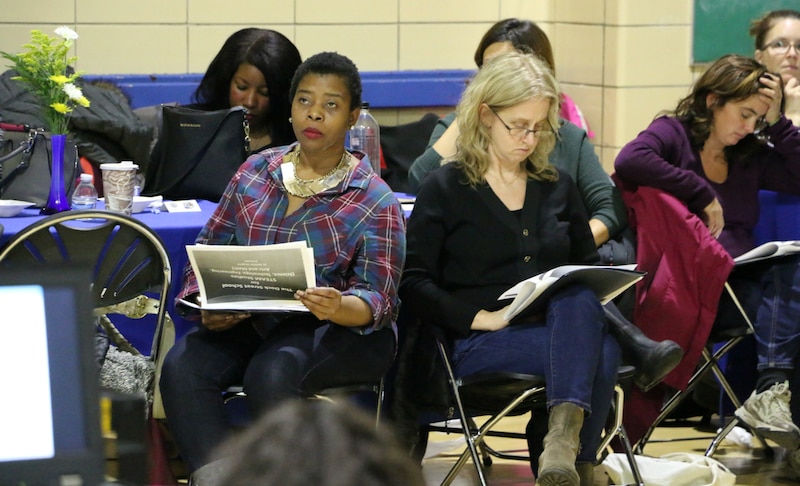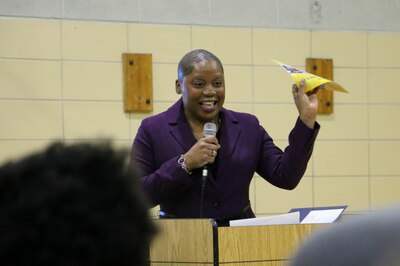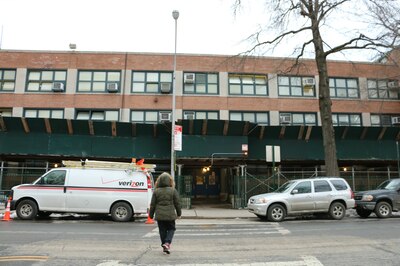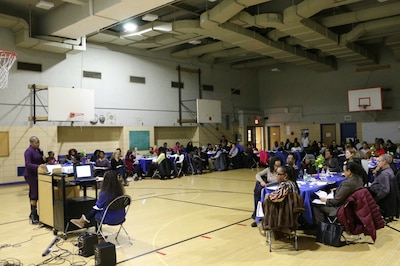
Come September, Satellite West Middle School will have disappeared.
By then, the troubled school will be moved from its shared brick building in Vinegar Hill, Brooklyn, into a sparkling glass condominium building at the foot of the Brooklyn Bridge. Nestled in the heart of chic Dumbo, the redesigned school will focus on science and art, enlist the neighborhood’s tech workers as mentors, and even go by a new name, The Dock Street School for STEAM Studies.
And, instead of using an admissions lottery, the school will begin handpicking its students.
Stay updated on New York City education news with our daily and weekly newsletters. Sign up here.
The transformation is one answer to a vexing riddle for New York City: How can middle-class families in gentrifying areas be convinced to send their children to local schools with less-than-stellar reputations?
But it also raises some prickly questions of its own: Must a struggling school become selective before middle-class families will give it a chance? And is the cost of wooing those families excluding others?
The potential rewards are high, since the influx of students and funding could help revitalize the district’s middle schools, keep the newcomers from decamping to private schools or moving, and create newly diverse classrooms, which research shows is beneficial to students. And Satellite West, which serves just 74 students, needs more applicants to stay afloat.
Because families can apply to any middle school in District 13, the swiftly gentrifying Brooklyn district where Satellite West is located, the city can’t just redraw zone lines to nudge more families into certain middle schools — the schools must entice parents to apply. So the district hosted forums and focus groups to ask families exactly what they are looking for in a middle school, and modeled the new school according to their tastes.
District leaders say the community-driven redesign process could provide a blueprint for other floundering middle schools.

“This is a unique, beautiful way to design a school,” Satellite West Principal Melissa Vaughan told parents at a recent presentation on the redesigned school.
That makes The Dock Street School a window into what some middle-class families seek in a school — in this case, a trendy theme, modern facilities, and a progressive bent. But perhaps even more consequential than how parents wanted the school to look and feel is who they wanted it to serve.
During the planning process, many parents said they wanted the new middle school to screen its applicants. The redesign team consented: While students who apply to Satellite West now are randomly selected, Dock Street will pick its students based on several criteria, including prior academic performance, officials said.
“If I stick around and take a leap of faith on a District 13 middle school that doesn’t have great test scores, I at the very least want to make sure there’s a peer group for my kid,” said Maggie Spillane, a P.S. 9 parent and redesign team member, summarizing parents’ remarks to the planners.

While the new admissions policy could help attract more of the district’s middle-class families to the school, it could also shut out other families.
Halley Potter, a fellow at the Century Foundation who studies school diversity, said that middle school programs that screen students can disadvantage those who attended less rigorous elementary schools. In practice, this often means that students end up sorted by class and sometimes race.
“I’d be really cautious” of screening students, she said, “if integration is one of the potential goals.”
A district of choice, in flux
In more ways than one, District 13 runs on choice.
An ever-growing number of middle-class families are choosing to settle in the district, which stretches from the rapidly redeveloping neighborhoods of Bedford-Stuyvesant and Fort Greene to solidly upper-class Dumbo and Brooklyn Heights. And many are choosing to send their children to increasingly popular local elementary schools, such as P.S. 9 and P.S. 11.
Yet most of the district’s dozen middle schools have not caught on in the same way. Most serve primarily low-income students of color and earn test scores far below the city average. (The two highest-performing schools — Academy of Arts and Letters and M.S. 8 — mainly admit students who attend the lower grades at their schools.)
While families can apply to any middle school in the district, many choose not to. Instead, those who can often send their children to private middle schools or selective citywide programs, or move to nearby District 15.
“Many parents don’t perceive a path to middle school,” said Gib Veconi, chair of the Prospect Heights Neighborhood Development Council. “So they leave the district or sometimes the neighborhood altogether.”
Satellite West, or M.S. 313, epitomizes the challenges facing most District 13 middle schools. It has a dwindling enrollment, low test scores (though they are comparable to those at other schools with many high-needs students), and a spot on the state’s list of most dangerous schools. Nearly 90 percent of its students come from low-income families, and not one is white.
In fact, the 99 total white students enrolled at Arts and Letters and M.S. 8 is more than double the number of white students at the district’s other 10 middle schools combined, according to an analysis of state data by Rob Underwood, a member of the district’s community education council. In a blog post, he said many white and non-white families are opting to send their children to middle schools out of the district.
“What is being done to create better options to retain kids in D13,” he wrote, “as they transition from elementary to middle?”
A new option, or a repackaged one?
For parents worried about the district’s dearth of high-performing middle schools, a new high-rise at 60 Water Street in Dumbo offered a glimmer of hope.
The building’s private developer included space for a 300-seat public middle school, which parents expected to house a new school. But in September, officials announced that they would relocate Satellite West into that space.

Because the announcement came during the debate over the rezoning of P.S. 307, which shares a building with Satellite West, some parent leaders assumed the move was meant to free up space for the elementary school to expand. But officials said the district did not need new middle schools — instead, it needed to draw parents into existing ones.
“The challenge was not that we didn’t have enough middle school seats, but that the schools were not meeting the needs of the community,” said Deputy Chancellor Elizabeth Rose, who oversees school facilities, in an interview.
Some parents saw the move as merely repackaging a struggling school, especially since the redesigned school would keep the same principal and teachers. Partly to quell those concerns, the district superintendent convened the redesign group with education department staffers, educators, parents, and students to survey the faculties and families at several local schools, and use their ideas to plan Dock Street.
Barbara Freeman, the district superintendent, said she wanted to assure parents that this was not just a move, but a “reimagining.” And the lessons of the redesign could also benefit the district’s other middle schools, she added, which are struggling to capitalize on the influx of new families.
“As the district continues to go forward with gentrification and the changes, how are we equipped to answer these big questions?” she said.
A decision to screen
One indication of what the redesign team would like to see The Dock Street School become is a middle school it visited during the planning process and held up as a model: M.S. 255 Salk School of Science, a prestigious school in Manhattan’s Gramercy neighborhood.
Salk screens applicants based on their test scores, grades, writing samples, and a science exercise, among other factors. The city asked Salk’s principal, Rhonda Perry, to serve as Vaughan’s mentor.
Cynthia McKnight, a P.S. 11 parent and member of the redesign team, said her older son attended Salk. While she loved the first-class education he received there, she said it came at the expense of diversity: He was the only black boy in his class, she said.
Last year, 85 percent of Salk students were white or Asian and only 10 percent received subsidized lunch, a measure of poverty. In District 2, where Salk students must live, 72 percent of students are white or Asian and 42 percent receive free or reduced-priced lunches.

While Dock Street plans to strive for greater diversity, McKnight said, many parents also made clear that they would not consider the school if it continued to admit any student who applied.
“A lot of parents wouldn’t send their children here if they didn’t have a screen,” she said.
Other parents said the desire for a selective school reflects the scarcity of District 13 options for high-performing students. In addition, it could help assuage concerns that Dock Street is just Satellite West rebranded, some said.
Officials are still finalizing the criteria that Dock Street will use to screen students, but Freeman said it would likely include students’ test scores, grades, attendance records, and their performance on a group project. The aim is to assess students “holistically,” she said.
Dock Street’s admissions criteria will be included on a new-school application form to be released next month, according to officials. But for now, it appears that some parents are still unaware of Satellite West’s pending transformation into a selective school.
Faraji Hannah-Jones, a P.S. 307 parent and outspoken critic of that school’s rezoning, said he was surprised to learn about the change, which he called a “recipe for disaster.” He said that in attempting to draw in more middle-class families, the policy risked excluding the neediest ones.
“If you’re going to have something like this that’s supposed to be special,” he said about the revamped school, “it should benefit the kids who need it most.”
Graphics produced by Stephanie Snyder.
